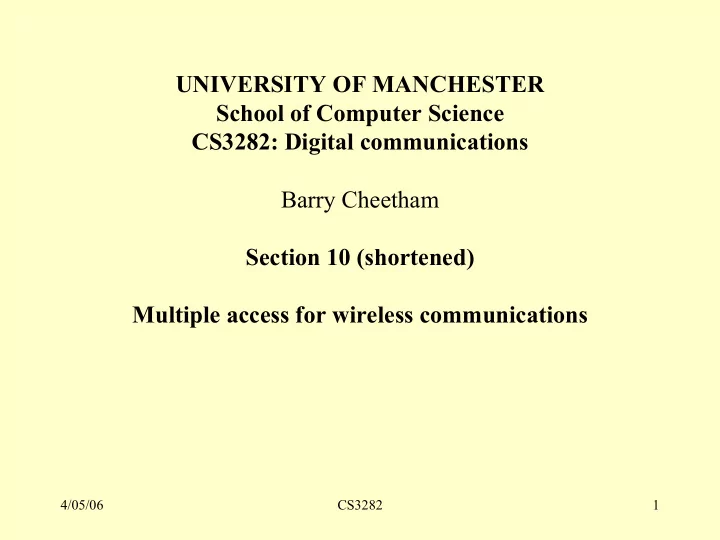

UNIVERSITY OF MANCHESTER School of Computer Science CS3282: Digital communications Barry Cheetham Section 10 (shortened) Multiple access for wireless communications 4/05/06 CS3282 1
Multiple user access for wireless communications Allow many users to share given amount of radio bandwidth. Three main techniques are: • Frequency division multiple access ( FDMA ) • Time-division multiple access ( TDMA ) • Code division multiple access ( CDMA ) (type of "spread spectrum multiple access" technique). To these add: • Space division multiple access ( SDMA ) (same band-width is re-used in different places) • Packet radio ( PR ) is a form of time division multiplexing (e.g.' CSMA/CA' as used by IEEE802.11). 4/05/06 CS3282 2
• Narrow-band systems : bandwidth used by a single channel lower than ‘coherence bandwidth’ B C . • Wide-band systems have bandwidth >> B C . • B C is range of frequencies over which fading can be considered flat i.e. all frequencies have same attenuation & delay. • Sine-waves with freq separation >> B C Hz affected differently. • If B C < 30 kHz, analogue mobile phone system with 30 kHz channels works without equaliser. • 900 MHz GSM with 200 kHz bandwidths requires equalisation. 4/05/06 CS3282 3
• FDMA divides available frequency range into sub-bands. � ‘AMPS’ uses 824-894 MHz band divided into 1664 channels, each 30 kHz with 10 kHz ‘guard-bands’. � Narrow-band channels so equalisation not needed • TDMA uses available frequency range by transmitting high frequency bit-stream containing data from many users. � Each user allocated cyclically repeating time-slot. � GSM divides 890-960 MHz into 200kHz channels by FDMA. � Transmits ≈ 271 kb/s in each channel by binary GMSK. (eight 25 kb/s speech channels) � Adaptive equalisation needed as 200 kHz > B C 4/05/06 CS3282 4
SSMA spread transmissions over wide bandwidth by using pseudo- random signals as carriers. • Different users have different pseudo random carriers . • Frequency hopping-SSMA : � Varies frequency of sine-wav carrier in pseudo-random fashion. � ’Fast’ & ‘slow’ hopping possible. � Provides security & immunity to effects of fading. • Direct sequence SSMA (CDMA) : � Base-band modulates a ‘spreading signal’. � Pseudo-random sequence of bits � High bit-rate called "chip-rate". � ‘Soft’ capacity limit; � Effects of multi-path reduced but power control is a difficulty. 4/05/06 CS3282 5
Hedy Lamarr (died 2000) Patented spread spectrum in early 1940s. Austrian born. First nude actress: appeared nude in Czech film ‘Ecstasy’. Before leaving advance of Nazi Germany & Adolf Hitler, married an Austrian arms merchant. Invented frequency hopping for secure radio communication based on frequencies of piano notes. 4/05/06 CS3282 6
Recommend
More recommend